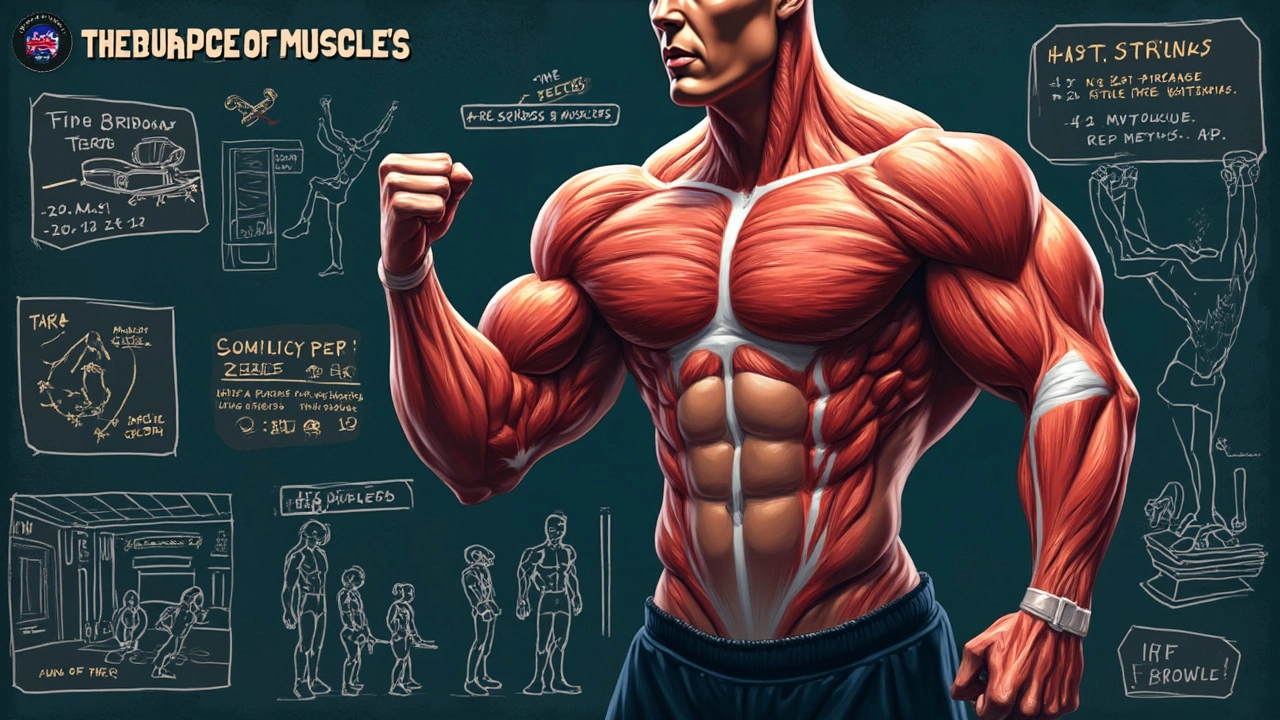
Wondering how many reps you should actually do to build muscle? You’re not alone. One day you hear it’s all about heavy weight and low reps, the next it’s higher reps until you can’t lift your arms. So, what actually works?
Here’s the simple truth: most muscles grow best with 6 to 15 reps per set. That doesn’t mean anything outside that range is useless, but it’s the sweet spot for people who want size without losing their minds figuring it all out. If you’re pushing fewer than five reps, you’re diving more into pure strength—think powerlifting territory. More than fifteen reps tends to drift toward endurance, and while it can build muscle too, it’s usually not the fastest way.
But this isn't just about picking a number and going. Two people can get very different results with the same program. Your level of experience, the exercise itself, and even how consistent you are all matter more than some magic rep number.
Sticking with the classic rep range makes life easier. You get enough volume to stress your muscles and enough weight to trigger growth. Ready for the details? Let’s break it down, so you can stop second-guessing and start seeing actual progress.
You might wonder, does the number of reps you do during a workout really make a difference in building muscle and getting stronger? Absolutely. The rep range you pick decides how your body responds to training—whether you get bigger, stronger, or just tired.
Let’s keep it real: muscles grow because you challenge them in certain ways. Science says that when you push your muscles with the right amount of resistance and volume, they get the signal to repair and grow. So when we talk about rep ranges, we’re basically talking about how we shape that signal.
Studies have stacked up the evidence. For example, a 2017 review by Brad Schoenfeld, who’s basically the go-to guy for muscle research, showed people gained just as much muscle doing 8–12 reps per set as those doing 20–25 reps, as long as they took their sets close to failure. Still, the mid-range (about 6–15 reps) tends to be easier for most folks to push hard and recover from, which is why it’s the gold standard for strength training and muscle growth.
Here’s a quick breakdown of what different rep zones usually target:
Picking the right rep range matters because it controls the total work your muscles do (volume), the rest you need, and even how likely you are to get hurt. If you’re just sticking to super low reps with heavy weights, your joints might hate you. If you only do high reps with tiny dumbbells, you’ll be sweating, but not necessarily growing. So the trick is to land in that zone where your body gets the perfect muscle-building signal.
Here’s a table that sums it up:
| Rep Range | Main Benefit | Ideal For |
|---|---|---|
| 1–5 | Strength | Powerlifters, heavy lifters |
| 6–15 | Muscle Size + Some Strength | Most people building muscle |
| 15+ | Endurance | Long sets, circuit workouts |
If you’re after solid workout tips, here’s one: Don’t overthink it. Start with that 6–15 rep zone, focus on good form, and go near failure. The rep range sets the stage for your whole plan. Next up, let’s see if that classic “8–12 reps” formula is actually as magical as people say.
For decades, coaches have said that doing 8-12 reps is the golden ticket for muscle growth—aka hypertrophy. You’ll find this rep range written in hundreds of articles and printed on gym walls everywhere. It’s based on actual research: studies have shown that the reps for muscle growth tend to land here if you want the most bang for your buck.
But here's the thing—your muscles can grow outside this range, too. A 2020 study out of Canada compared folks lifting heavy (4–6 reps) versus lighter weights (20–25 reps) to failure. Both groups saw muscle gains. The key factor? Working close to failure, not just the rep number. Still, the 8–12 reps zone remains popular because it blends heavy-enough weights to trigger new muscle and enough total volume so the workout doesn’t end in one minute.
Why does this middle range work well? It strikes a balance between mechanical tension (the muscle pulling against weight) and metabolic stress (the "pump" you feel). Both are important for building muscle. Plus, form is less likely to break down with moderate reps vs. going super heavy. Less risk of hurting yourself, more gain for the effort.
If we look at some research data, you’ll see why most people stick with this classic range:
| Rep Range | Type of Training | Common Goal |
|---|---|---|
| 1-5 | Strength | Powerlifting/Max Strength |
| 6-12 | Hypertrophy | Muscle Size |
| 15+ | Endurance | Stamina |
This doesn’t mean you should never dip below or above that window. But if you want a reliable starting point, the strength training experts still recommend 6–12 reps as the main event for muscle.
Bottom line? The classic hypertrophy range is not just gym legend—it’s backed by science. It works for most people, is easy to stick with, and is safer than super low reps. If you want to shake it up, try mixing a few heavier or lighter sets in now and then, but keep your core sets in the muscle-building zone for solid results.

Here’s the twist: the ideal reps for muscle growth is not the same for everyone. Your muscle-building results depend on a bunch of personal stuff that goes way beyond what you see on some perfect Instagram post.
First off, genetics actually matter. Some people naturally respond better to higher or lower rep ranges just because of their muscle fiber type. Fast-twitch fibers (the ones used for explosive, heavy lifts) thrive on lower reps and heavier weight, while slow-twitch folks might find themselves getting better results from slightly higher reps. It’s not always obvious what fiber type you have until you experiment a bit.
Age also flips the script. If you’re over 40, your body recovers slower and joints can be grumpier. You might do better with moderate reps (like 8-12) to limit stress but still push your muscles. At the other end, teenagers and twenty-somethings can often recover quicker and handle a bit more volume—lucky them.
Experience level is huge. If you’re new to strength training, you don’t need fancy programming. Even sets of 10-12 will make you stronger and help build muscle. As you get more advanced, you’ll need more intensity or variety.
Here are some personal factors that really take charge:
Take it from Brad Schoenfeld, a top muscle-building researcher:
“There’s no one-size-fits-all when it comes to rep ranges. You have to pay attention to your body and adapt based on your own progress.”
Fun fact: A 2017 study in the Journal of Strength and Conditioning Research had two groups do either 8–12 reps or 25–35 reps per set, with both groups growing muscle. The main factor? Both sets worked hard and came close to failure, regardless of the actual numbers. So, if you’re pushing yourself and staying consistent, you'll get stronger and see actual muscle changes, no matter where you land on the reps for muscle growth chart.
Picking the right reps for muscle growth isn’t as confusing as people make it out to be. It all comes down to your goal, your equipment, and honestly—what you enjoy enough to stick with. Here’s what you need to know on a practical level:
The magic isn’t just in the rep number. It’s about hitting the right intensity. Fatiguing your muscle near the end of a set—whether it’s at 8 reps or 15—still sends the “grow!” signal. A 2020 review in the journal Sports Medicine found that muscle gains were similar across moderate (8–12 reps) and higher rep (15–20+) ranges, as long as the effort was high. Doesn’t mean you have to train to failure every time, but each set should feel pretty tough by the end.
"The optimal range for building muscle is between 6 and 12 repetitions per set, with rest intervals of 60–90 seconds." – American College of Sports Medicine
Let's get more specific. The best strength training program lines up your reps with your type of exercise:
| Goal | Rep Range | Typical Load (% 1RM) |
|---|---|---|
| Muscle Growth | 6-12 | 65–85% |
| Strength | 4-6 | 80–90% |
| Endurance | 15+ | Less than 60% |
Another tip: your experience matters. Newer lifters can usually build muscle easily with anything between 6 and 15 reps, as long as they push themselves. More advanced folks may need to switch up their rep ranges to keep growing.
Don’t forget to trust your body and keep it fun. My husband, Nathaniel, loves lower rep, heavier work because it keeps him motivated and tracking progress. Me? I switch up rep ranges every few weeks because I get bored easily and my muscles seem to like the change. Find what keeps you coming back to the gym. That—plus honest effort in the right rep range—is what really gets results.

Nailing the right rep range is just one piece of the puzzle. Even when you pick the right number, there are a few common slip-ups that can slow down your strength training gains. Don’t let simple mistakes kill your progress—these tips will keep you on track and help those muscles show up for real.
Here’s a quick look at how different rep ranges affect your results:
| Rep Range | Goal | Typical Weight (% 1RM) | Muscle Growth Potential |
|---|---|---|---|
| 3-5 | Strength | 85-95% | Medium |
| 6-12 | Building muscle | 65-80% | High |
| 13-20 | Endurance | 50-65% | Medium |
Last thing—don’t compare your journey to the ripped guy at the gym or the fitness model online. Your body, your genes, your history, and your habits all play a role. Stay consistent, keep workouts honest, track your muscle growth and you’ll see changes. Strong is strong, no matter how you get there.